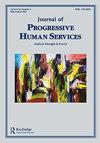Examining Profiles of Poverty by Race in America: Policy Implications of a Multi-Dimensional Measure
IF 0.8
Q1 SOCIAL WORK
引用次数: 0
Abstract
ABSTRACT A looming question for U.S. social policy is whether the over 50-year old federal poverty measure paints an accurate picture of the poor in America today. A panel of experts from the National Academy of Sciences (NAS), commissioned by Congress to address the key shortcomings of the federal measure, proposed an alternative poverty measure in the early 1990s that laid the groundwork for the Supplemental Poverty Measure adopted in 2010. However, while, internationally, poverty scholars have argued that poverty is more aptly understood as a constellation of deprivations – a multi-dimensional concept, U.S. poverty measurement continues to focus on economic deprivation. Amartya Sen’s groundbreaking capability approach that focuses on individuals’ capacities provides the framework for the author-created multi-dimensional poverty index encompassing three dimensions Sen considers intrinsically valuable capabilities: education, health, and living standard. Drawing on publically available secondary data, this study adopts a comparative framework to examine national-level racial differences in profiles of poverty, pre-and post-the Great Recession (2005–2010), based on the federal poverty measure, the NAS measure, and the proposed multi-dimensional measure. This multi-dimensional perspective thus offers insights into the type of capability disadvantages contributing to poverty among the citizenry by race.考察美国种族贫困概况:多维尺度的政策含义
摘要美国社会政策面临的一个迫在眉睫的问题是,有着50多年历史的联邦贫困衡量标准是否准确地描绘了当今美国的贫困状况。美国国家科学院(NAS)的一个专家小组受国会委托,解决联邦措施的主要缺点,在20世纪90年代初提出了一项替代贫困措施,为2010年通过的补充贫困措施奠定了基础。然而,尽管在国际上,贫困学者认为贫困被更恰当地理解为一系列剥夺——一个多维度的概念,但美国的贫困衡量仍然侧重于经济剥夺。Amartya Sen专注于个人能力的开创性能力方法为作者创建的多维贫困指数提供了框架,该指数包括三个维度,Sen认为这些能力具有内在价值:教育、健康和生活水平。根据公开的二次数据,本研究采用了一个比较框架,以联邦贫困衡量标准、NAS衡量标准和拟议的多维衡量标准为基础,考察大衰退前后(2005-2010年)国家层面的贫困状况种族差异。因此,这种多维度的视角可以深入了解按种族划分的导致公民贫困的能力劣势类型。
本文章由计算机程序翻译,如有差异,请以英文原文为准。
求助全文
约1分钟内获得全文
求助全文
来源期刊

Journal of Progressive Human Services
SOCIAL WORK-
CiteScore
3.20
自引率
8.30%
发文量
14
期刊介绍:
The only journal of its kind in the United States, the Journal of Progressive Human Services covers political, social, personal, and professional problems in human services from a progressive perspective. The journal stimulates debate about major social issues and contributes to the development of the analytical tools needed for building a caring society based on equality and justice. The journal"s contributors examine oppressed and vulnerable groups, struggles by workers and clients on the job and in the community, dilemmas of practice in conservative contexts, and strategies for ending racism, sexism, ageism, heterosexism, and discrimination of persons who are disabled and psychologically distressed.
 求助内容:
求助内容: 应助结果提醒方式:
应助结果提醒方式:


